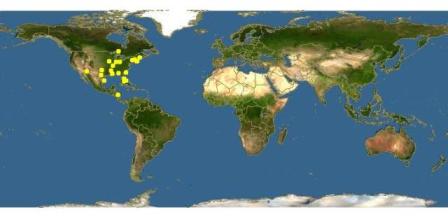Habitat
Gastrocopta tappaniana (C.B. Adams, 1842) inhabits a wide range in North America and parts of Central America as well. This species has been found in many places in the United States ranging from Maine to Georgia, west to South Dakota, Kansas, and Arizona (Burch, 1962).
This particular species of snail prefers to live in low, moist places, many times under wood (Pilsbry, 1948). It has often been observed that Gastrocopta tappaniana prefers to live in lowland grasslands and forests (Nekola, 2003). The environment is usually shady which helps prevent the snail from exposure to extreme heat and at risk of drying out.
Snails, in general, also tend to live in environments where calcium concentrations in the soil are high because snails need the calcium to build and maintain their shells (Illinois Department of Natural Resources, 2009).
In a study conducted by Timothy A. Pearce, Gastrocopta tappaniana was found underneath leaf-litters and closer to bodies of water. Gastrocopta tappaniana was found to co-exist with Gastrocopta pentodon in this study conducted on the Delmarva Peninsula in eastern United States. Throughout the study, G. tappaniana was generally found in wetter areas when compared to the areas where G. pentodon inhabit (Pearce, 2007).
Grasslands are very important to Gastrocopta tappaniana. Due to this environment however, this species has had to face a significant problem. Fire management has been used for years in many central North American grasslands in order to remove the soil mulch layer that hinders some plant species’ growth in the spring. These fires occur in 2-6 year intervals and there are many plant species that actually thrive after a fire has spread through the grassland as their growth and reproductive rates increase. However, in a study conducted by J.C. Nekola, it has been shown that land snail community richness and abundance has been reduced in many grassland areas that have been burned. Many snails live within five centimeters of the soil surface so when the mulch layer is burned, the abundant amount of protection is also removed.
One of the species affected in this study was Gastrocopta tappaniana which was shown to be negatively impacted after a fire burned through grasslands where this species was living. G. tappaniana was one of many species where the population had decreased after a fire. The results of the study indicated that the mulch layer is very much needed to add protection to the snail populations. In addition, the soil biota could be protected if the fires were to go to 20-30 year intervals instead of 2-6 year intervals. With these changes, land snail population will be able to be conserved (Nekola, 2002).
To find out more information on other snail species or other species in general, visit the Discover Life website at http://www.discoverlife.org/.
Back to Home Continue to Adaptation
